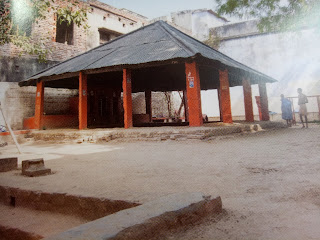Tulsi Akhara: Fight Club of Varanasi
 |
| The wrestling rink at Tulsi Akhara |
Akharas (wrestling clubs) are the original
gymnasiums of India, often to show their wrestling prowess. “A regular day in
the akhara begins at six am with dand baithaks (sit-ups) or jori phirna
(turning around a pair of wooden cylinders tapering at one end, filled usually
with iron or concrete). This is followed by yoga routines such as the
suryanamaskar (obeisance to the sun and yoga warm up routine) and push-ups,”
says Pehelwan Siyaramji, as he introduces me to the yoga instructor Subhashji. By
now, there are about 20 men, of all ages, in the akhara wearing just a red
loincloth.
Two wrestlers enter the muddy rink and prostrate at
the mud. The fight among them begins with a loud roar of “Jai Bajrangbali”
(Victory to Hanuman). While the game is in progress, Siyaramji urges his men to
keep their calm and instead, concentrate on the heat produced in the body.
A
young wrestler has lost his balance and Siyaramji brings him under the shade of
the peepal tree and applies mud on his body. He then asks him to wait until it dries
on his body. Reacting to the surprise on my face, he smiles and says, “The
mitti (mud) here resembles the bhasma (ash) on Baba Vishwanathji’s (Lord Shiva)
body. In every akhara, the mitti is smooth and soft, having been brought
specially from the river below. The mitti is a natural remedy for sprains and
wounds. Sometimes, we add haldi (turmeric), kachchi ghani tel (mustard oil),
salt and lemon juice, with camphor thrown in for fragrance.” The mud in the
wrestling rink is often sourced from the Ganga or brought from nearby villages.
It is then mixed with curd, mustard oil, turmeric and neem leaves to infuse it
with therapeutic properties so that wrestlers are not vulnerable to infections
or cold.
Sensing my discomfort of sitting on the floor, yoga
instructor Acharya Subhashji asks me to stand on one foot with my hands joined
in a namaste pose above my head. This, he says, will lead to an improvement in
posture. He further urges me to sit on the floor often to minimise knee and
joint pains. Sitting on the floor, he says, leads to the straightening of the
back and the spinal chord.
In Hindu
traditions, Ahiravana (Ravana’s brother) abducted Rama and Lakshmana and took
them to the subterranean realms of the universe. Hanuman, the son of wind
promptly followed to rescue them. At the entrance, Hanuman was stopped by a
child named Makardhwaja who bore the face of a part monkey and a part reptile. The
young Makardhwaja challenges Hanuman to a fight in which Hanuman emerges
victorious. Rescuing Rama and Lakshmana, Hanuman wanted to meet Makardhwaja’s
parents. Makardhwaja reveals his father’s name as Hanuman. A shocked Hanuman
said that he is celibate. Makardhwaja recounts Hanuman’s journey when he was
flying back from Lanka after setting the city ablaze, a drop of his sweat fell
in the ocean. A crocodile swallowed it, leading to Makardhwaja’s birth. In
Hindu iconography, Makardhwaja is represented as a part monkey and a part
reptile. The wrestling match between Makardhwaja and Hanuman is one of the main
reasons why every akhara sports either a photograph or an idol of Hanuman and
all wrestlers identify with the devotee of Lord Rama, who being the son of
wind, is also associated with immense strength.
Wrestling, as a sport, has been found in the
Ramayana and Mahabharata through characters like Vali, Angad, Hanuman,
Jarasandha, Bhima and Kamsa. It is only around the 14th century,
there is a book titled “Malla Purana” which is often considered as the manual
for every wrestler. The text outlines the composition of a wrestler, the diet
of a wrestler and ways to keep him fit among others. Around the same time,
India also came in contact with the Mughals. Babur brought with him central
Asian styles of wrestling. However, it is during the reign of Akbar that
central Asian styles merged with the Indian ones, thereby evolving into a new
form of wrestling called kushti, from the Persian word “kusht”, to wrestle.
Visiting the akhara was a very humbling experience
as it allowed me to revisit traditional Indian systems of knowledge and
fitness. As the sun rays get stronger, the wrestlers come back to rest under
the shade of the peepal tree. Adjusting their red langots (loincloths) and
gamchhas (scarves), they sip water while Pehelwan Siyaramji crushes neem leaves
with a sculpted stone and mixes it with spices to prepare bhang. Bhang is
prepared from the cannabis plant and is a special favourite in Varanasi. When
consumed, it results in a spirit of mauj (carefree attitude). It can be had in
many forms, the most common being thandai (an Indian cold drink prepared with
almonds, fennel seeds, rose petals, pepper, cardamom, saffron, milk and sugar).
Pehelwan Siyaramji offers me some in a big glass made of brass, which I politely
refuse.
It is now nearing 10 am and the wrestlers chant “Jai
Bajrangbali”, the last for the day, as they disband and disappear into the
crowds of the city to return to their daily grind of life.


Comments